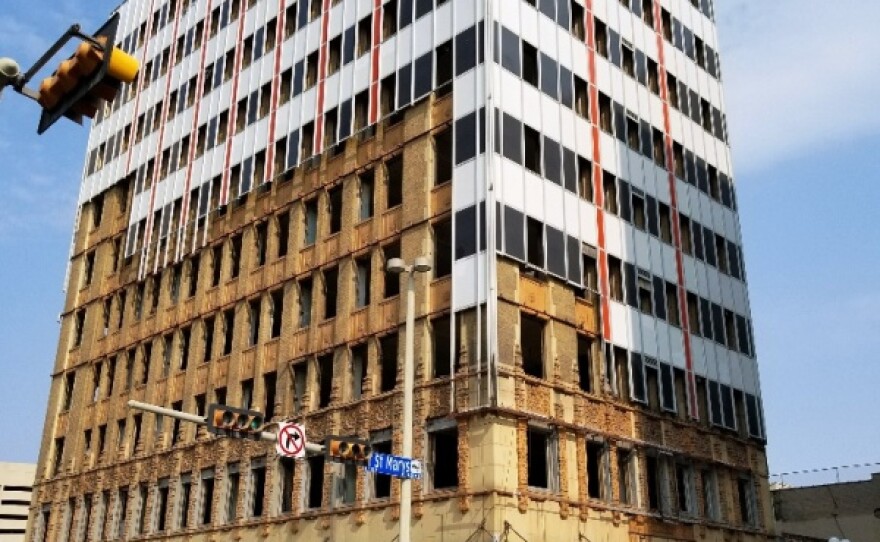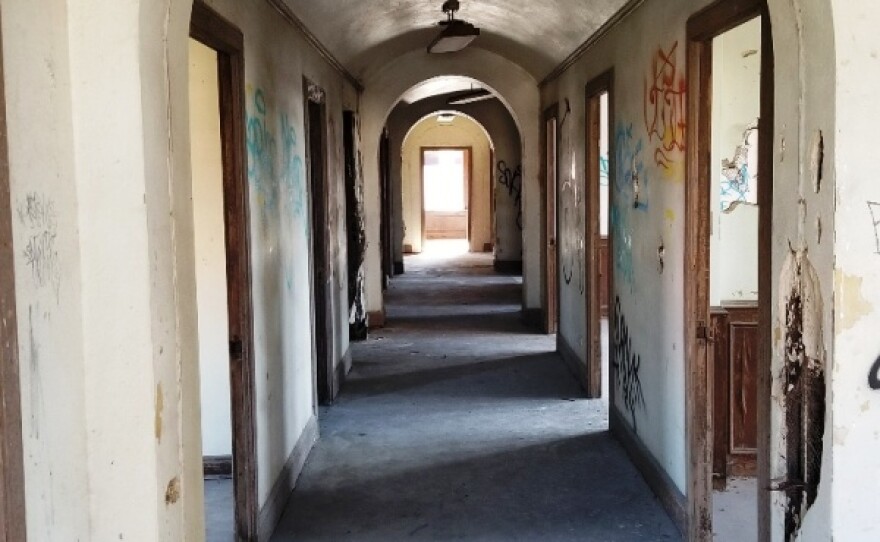Although no new buildings have been completed recently, the San Antonio skyline has seen a dramatic change in recent weeks.
Built in 1928, the ten-story Hedrick Building at St. Mary's and Martin Streets was built originally with brick in brown and tan earthen tones. Ornate, flower detailing made of molded, fired terra cotta are featured prominently on the two bottom floors.
""The decoration is Spanish Baroque. Much like the telephone company building about three blocks away," Dr. Maggie Valentine says. She teaches architectural history and interior design at UTSA.
The Spanish Baroque detailing can be found all around San Antonio on older buildings of that era. By 1963, however, the Hedrick's better days were behind it, so the owner changed the exterior spectacularly – and by current tastes, not in a good way.
"If Timothy Leary was an architect, he would've designed this metal cladding," Developer Craig Glendenning says, likening the silver, white and red-striped cladding to a similar aesthetic of the counterculture icon.
Glendenning says he doesn't like the cladding, which is essentially an aluminum skin attached to the building's original surface.
Valentine says architectural trends had passed the Hedrick by.
"By the 1960s, it looked old fashioned," she says. "It was dirty and needed to be cleaned, so they just covered it up. Thank goodness they covered it up and didn't tear it down."

And oddly, Glendenning says the aluminum addition wasn't always considered a monstrosity. Ironically, the cladding won the Hedrick a Renovation of the Year award.
"It got an award for modernization," Valentine said. "That was a result of the time at which it was done and the attitudes of architecture. By that time Beaux's arts and European styles were passe and they wanted something bright and clean."
According to Valentine, at the time, architecture in the United States was struggling to find its sense of self.
"About the turn of the century, there was a contest in architectural thought between classicism and Americanism," she says. "Frank Lloyd Wright and Louis Sullivan wanted an architecture that expressed this continent, and this country, instead of Europe. And that battle went on for about 50 years."
World War II diverted attention to more important matters, but Valentine says that afterwards, the movement started up again.
"The post-war [architects] wanted to break away as far as they could from the pre-war era. And it was cheaper to use materials like aluminum. It all looked brand new," she says.
Most of the architectural trends that have dominated American skylines the last 50 plus years began after the war. Fast-forward to the current day where many see the structure's look in a different light.
"It was such an eyesore," Valentine says. "And it stood out from everything around it and the direction that downtown was going."
The developer Glendenning had been tapped by the owner to execute the re-imagining of the Hedrick into The Flats on St. Mary's, a mixed use residential development. But first they had to know: what exactly was left behind that aluminum cladding?
"We'd been able to use cameras and get some idea that the facade was mostly intact. But we had no idea how ornate and how well-preserved and how really, frankly, how beautiful it is."
That architectural filigree – the terra cotta-like Spanish colonial detailing – was left largely intact underneath that aluminum.
"We started construction – or demolition – a little over a month ago on the exterior facade. And it's remarkably beautiful and well-kept."
The building qualified for tax breaks from both the city and state, which helped make the massive remodeling viable. Those incentives helped a lot because as they got started, it turned out that a building that had been empty for decades really wasn't vacant.
"There was a highly prolific pigeon colony that roosted on the top five floors."
They hauled a dozen truckloads of pigeon guano away, and now, all the aluminum cladding has been hauled, too. But not to the dump.
"Great Northwest Recycling here in San Antonio. That and all the metals are going through recycling and we're trying to use all the metals we can."
As to what The Flats on St. Mary's will be, here's how Glendenning describes it.
"The top floors – two through ten – are apartments. There'll be 54 apartments that range from about 500 square feet, up to about 720 square feet. The rents will begin around $1,000."
Valentine says that saving the Hedrick could really change that part of downtown.
"It keeps a city alive night and day. There are offices near there, there will be homes there, there will be shopping and restaurants, and we'll get night life back in that neighborhood."
And she notes that the building that was such an eyesore isn't one anymore.
The developer says the Voss building next door may well be a 24-hour coffee bar within 9 months, and a rooftop music venue before much longer.

















